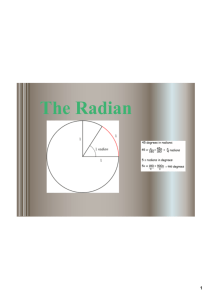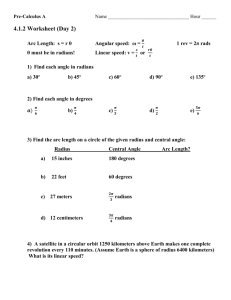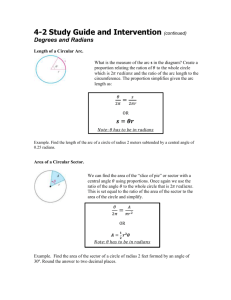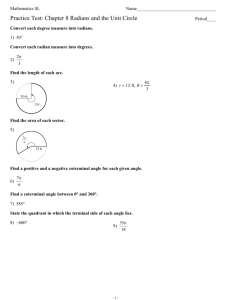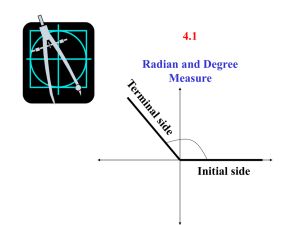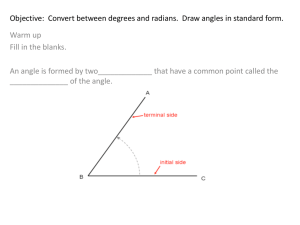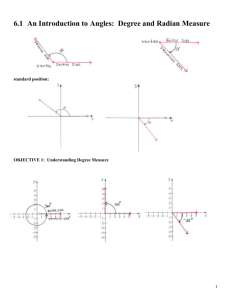Lesson 7-1 - TeacherWeb
advertisement
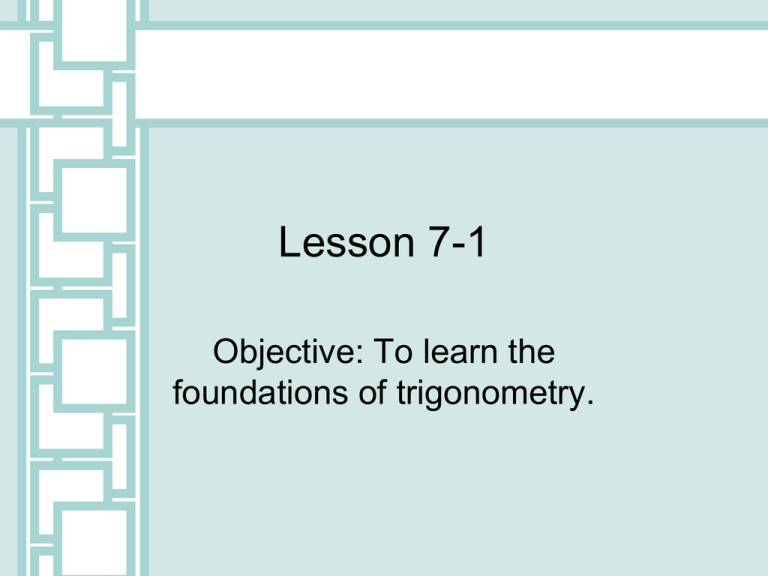
Lesson 7-1 Objective: To learn the foundations of trigonometry. Trigonometry The branch of mathematics that studies right triangles. It deals with the relationship between the sides and the angles. In order to do this you must also understand the relationship between angles and circles. Angles • An angle is formed by two rays with a common endpoint. (geometry definition) • An angle is the result of a rotation of a ray about its endpoint. (trigonometry definition) Standard Position When the initial side is on the positive x axis and the endpoint is on the origin Then the angle is in standard position. Positive Angle – Standard Form α Negative Angle – Standard Form β Quadrant I • Where the terminal side lays is where the angle is said to lie. Between 0o and 90o or 0 and 2 Quadrant II Between 90o and 180o or and 2 Quadrant III Between 180o and 3 o 270 or and 2 Quadrant IV Between 270o and 3 o 360 or 2 and 2 Quadrantal • When the terminal side lies on an axis it is called a quadrantal. Angular Measurement 1 360 • Degree of a complete rotation in the counterclockwise direction. 1o Angular Measurement 1 360 • Degree of a complete rotation in the counterclockwise direction. 10o Angular Measurement 1 360 • Degree of a complete rotation in the counterclockwise direction. 45o Angular Measurement 1 360 • Degree of a complete rotation in the counterclockwise direction. 90o Angular Measurement 1 360 • Degree of a complete rotation in the counterclockwise direction. 150o Angular Measurement 1 360 • Degree of a complete rotation in the counterclockwise direction. 225o Angular Measurement 1 360 • Degree of a complete rotation in the counterclockwise direction. 315o Angular Measurement 1 360 • Degree of a complete rotation in the counterclockwise direction. 359o Review -Classifying Angles Acute Angle - measure greater than 0 degrees and less than 90 degrees Review-Classifying Angles Obtuse - measure more than 90 degrees and less than 180 degrees (in Quadrant II) Review - Classifying Angles Right - measure 90 degrees (Quadrantal) Radian Measure • To talk about trigonometric functions, it is helpful to move to a different system of angle measure, called radian measure. • A radian is the measure of a central angle whose intercepted arc is equal in length to the radius of the circle. 23 ©Carolyn C. Wheater, 2000 Radian Measure • There are 2 radians in a full rotation once around the circle ( is half a rotation) • There are 360° in a full rotation (180 ° in half a rotation) • To convert from degrees to radians or radians to degrees, use the proportion: degrees = radians 180° 24 ©Carolyn C. Wheater, 2000 Sample Problems • Find the degree measure 3 equivalent of 4 radians. degrees radians 360 2 d 3 4 360 2 2d 270 d 135 Find the radian measure equivalent of 210° degrees radians 360 2 210 r 360 2 360r 420 420 7 r 360 6 Radians (cont’d) • Typically the angle is referred to as θ (theta) • Some standard angle conversions • radians = 180o • 1 radian =(180 )o • 1o = 180 radians Examples • Convert from degree to radian measure: • -210o • 390o Examples • Convert from radian measure to degrees. • • 9 radians 2 4 3 radians
